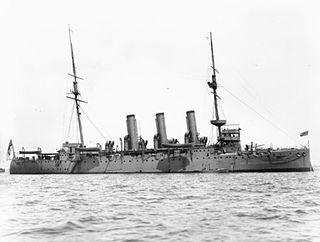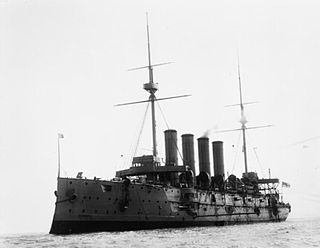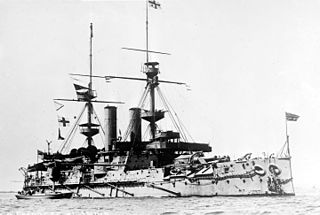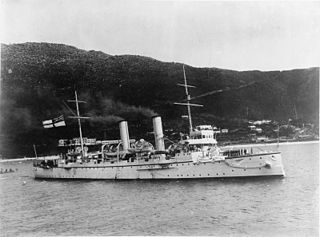
HMS Gladiator was a second class protected cruiser of the Royal Navy, launched on 8 December 1896 at Portsmouth, England. She was of the Arrogant class rated at 5,750 long tons (5,840 t) displacement, with a crew of 250 officers and men. She had three distinctive stacks amidships with a conspicuous bridge well forward.

HMS Fox was a second class protected cruiser of the Astraea-class of the Royal Navy. The class represented an improvement on previous types, 1,000 tons displacement larger with better seaworthiness due to improved hull design. It also had somewhat increased firepower and superior arrangement of guns.

HMS Hawke, launched in 1891, was the seventh British warship to be named Hawke. She was an Edgar-class protected cruiser.

HMS Hermione was an Astraea-class Royal Navy protected cruiser launched at Devonport in 1893. She served in World War I and was sold in 1921. She was renamed training ship Warspite in 1922, and broken up in 1940.
William Harold Owen was the younger brother and biographer of the English poet and soldier, Wilfred Owen. He was born at the home of his paternal grandparents in Canon Street, Shrewsbury, Shropshire, where his parents and older siblings then lodged before his father moved on promotion to a station master's post at Birkenhead in 1898.

HMS Doris was an Eclipse-class protected cruiser built for the Royal Navy in the mid-1890s.

HMS Diadem was the lead ship of the Diadem-class of protected cruiser in the Royal Navy.

HMS Amphitrite was a ship of the Diadem-class of protected cruisers in the Royal Navy, which served in the First World War.

HMS Andromeda was one of eight Diadem-class protected cruisers built for the Royal Navy in the 1890s. Upon completion in 1899, the ship was assigned to the Mediterranean Fleet where she helped to escort a royal yacht during its cruise through the Mediterranean Sea. After a refit, she was assigned to the China Station in 1904 and returned home three years later to be reduced to reserve. Andromeda was converted into a training ship in 1913 and remained in that role under various names until 1956. That year she was sold for scrap and broken up in Belgium, the last Pembroke-built ship still afloat.

HMS Europa was a ship of the Diadem-class protected cruisers in the Royal Navy. She was built by J&G Thompson of Clydebank and launched on 20 March 1897.

HMS Vindictive was a British Arrogant-class cruiser built at Chatham Dockyard. She was launched on 9 December 1897 and completed in 1899. The vessel participated in the Zeebrugge Raid.

HMS Empress of India was one of seven Royal Sovereign-class pre-dreadnought battleships built for the Royal Navy during the 1890s. The ship was commissioned in 1893 and served as the flagship of the second-in-command of the Channel Fleet for two years. She was transferred to the Mediterranean Fleet in 1897, during which time Empress of India was assigned to the International Squadron blockading Crete during the uprising there. She returned home in 1901 and was briefly assigned as a coast guard ship in Ireland before she became the second flagship of the Home Fleet. The ship was reduced to reserve in 1905 and accidentally collided with the submarine HMS A10 the following year. Empress of India was taken out of service in early 1912 and accidentally struck a German sailing ship while under tow. She was sunk as a target ship in 1913.

HMS Talbot was an Eclipse-class protected cruiser built for the Royal Navy in the mid-1890s.

HMS Flora was an Astraea-class cruiser of the Royal Navy launched on 21 November 1893. She was constructed under the Naval Defence Act 1889 along with several other Astraea-class cruisers. Flora was decommissioned in 1922.

HMS Dryad was the name ship of the Dryad-class torpedo gunboats. She was launched at Chatham Dockyard on 22 November 1893, the first of the class to be completed. She served as a minesweeper during World War I and was broken up in 1920.

HMS Isis was an Eclipse-class protected cruiser built for the Royal Navy in the mid-1890s.

HMS Dido was an Eclipse-class protected cruiser built for the Royal Navy in the mid-1890s.

HMS Mallard was a two funnel, 30-knot destroyer ordered by the Royal Navy under the 1894 – 1895 Naval Estimates. She served in Home waters both before and during the First World War, and was sold for breaking in 1920.

HMS Cygnet was a two funnel, 30 knot destroyer ordered by the Royal Navy under the 1896 – 1897 Naval Estimates. She was the thirteenth ship to carry this name. She was launched in 1898, served in the Chatham division before World War I and was tendered to the gunnery school at Sheerness during the war. She was sold for breaking in 1920.

HMS Forte was an Astraea class cruiser of the Royal Navy launched on 9 December 1893. She was constructed under the Naval Defence Act of 1889 along with several other Astraea class cruisers. Forte was eventually decommissioned in 1913.



















